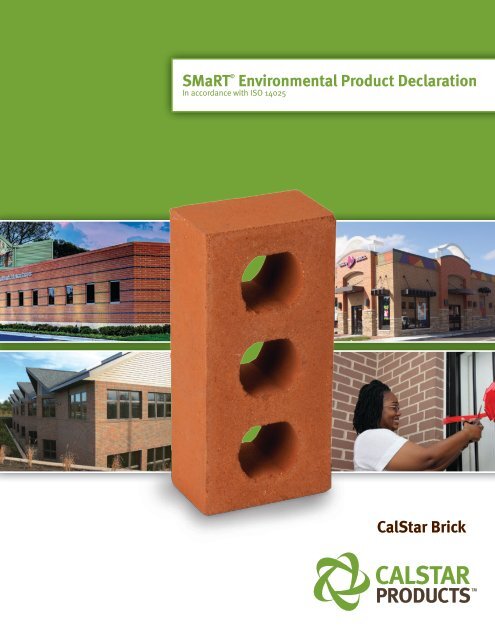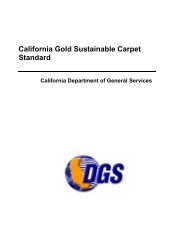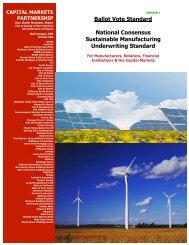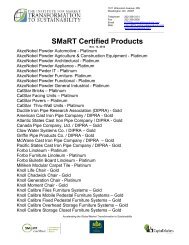CalStar Products SMaRT EPD - MTS
CalStar Products SMaRT EPD - MTS
CalStar Products SMaRT EPD - MTS
Create successful ePaper yourself
Turn your PDF publications into a flip-book with our unique Google optimized e-Paper software.
<strong>SMaRT</strong> © Environmental Product Declaration<br />
In accordance with ISO 14025<br />
<strong>CalStar</strong> Brick
Product Description:<br />
Bricks have long been prized for their classic look, durability, and weather resistance. <strong>CalStar</strong> <strong>Products</strong>, Inc. has<br />
developed a proprietary new manufacturing process that reduces manufacturing energy requirements, while producing<br />
bricks that meet industry standards, without compromising project aesthetics or budgets. <strong>CalStar</strong> modular-sized<br />
brick (3 5/8 x 2 ¼ x 7 5/8 inches) were used for this analysis.<br />
<strong>CalStar</strong> bricks are designed and intended to be used anywhere bricks are used. <strong>CalStar</strong> bricks meet the performance<br />
requirements discussed in ASTM C216 Standard Specification for Facing Brick (Solid Masonry Units Made from Clay or<br />
Shale), though <strong>CalStar</strong> bricks are not made of clay or shale. They are installed using the same materials (mortar) with<br />
the same labor (masons) on the same projects.<br />
<strong>CalStar</strong> bricks contain 37.1% fly ash, which is a post-industrial (pre consumer) recycled material. Fly ash is a waste<br />
product of generating electricity from coal, which is generally disposed of in landfills. The <strong>CalStar</strong> process uses fly<br />
ash as the binder in bricks, eliminating the need for clay, kiln firing or Portland cement. The entire manufacturing time<br />
for a <strong>CalStar</strong> brick from raw material delivery to packaging is approximately 24 hours. The <strong>CalStar</strong> process requires<br />
very little energy during the life cycle—especially the manufacturing stage—and, as a result, has a small carbon footprint.<br />
<strong>CalStar</strong>’s commitment to environmental performance includes carbon reduction, embodied energy reduction, recycling<br />
industrial waste, and waste diversion from landfills. <strong>CalStar</strong> purchases Renewable Energy Credits (RECs) from wind energy<br />
to offset half of the manufacturing energy usage. This renewable energy was deliberately not taken into account during<br />
the life cycle assessment (LCA). The LCA values shown in this document represent the complete life cycle of <strong>CalStar</strong> bricks,<br />
without accounting for the RECs purchased by <strong>CalStar</strong>.<br />
Manufacturer:<br />
<strong>CalStar</strong> <strong>Products</strong>, Inc. develops and manufactures sustainable building products that allow customers to dramatically<br />
reduce the embodied energy and carbon footprint of their projects and incorporate significant recycled materials, without<br />
compromising building performance or budgets. Founded in Silicon Valley and headquartered in Wisconsin, <strong>CalStar</strong>’s<br />
mission encompasses the national priorities of supporting energy independence, mitigating climate change, preserving<br />
natural resources, recycling industrial waste, and creating green jobs.<br />
For more information, visit http://www.calstarproducts.com<br />
Material Declaration:<br />
<strong>CalStar</strong> modular bricks are composed of the materials listed in<br />
this table. (The table shows materials comprising 1% or more by<br />
weight.) A single modular brick weighs 4.2 lbs and contains 37.1%<br />
post-industrial recycled content (fly ash). Bricks are packaged in cubes,<br />
with 525 modular bricks in a cube. Cubes are strapped together using<br />
recyclable polyester plastic straps. Cubes are then stretch-wrapped,<br />
using recyclable low-density polyethylene.<br />
material weight/brick (lb) amount of mixture<br />
sand 2.34 55.8%<br />
fly ash 1.56 37.1%<br />
water 0.25 5.9%<br />
2
Environmental Product Declaration:<br />
<strong>CalStar</strong> and its users, owners, employees, and stakeholders possess a shared interested in the environment with<br />
particular focus on mitigating climate change through the reduction of product-related embodied energy and<br />
associated greenhouse gas emissions. As such, <strong>CalStar</strong> commissioned an ISO-compliant life cycle assessment from<br />
leading architectural firm, Perkins+Will, to assess the environmental impacts of a <strong>CalStar</strong> brick throughout its entire<br />
life cycle—including raw materials extraction and transportation, brick production, transportation to job site, use, and<br />
end-of-life. The functional unit used in the LCA is one modular brick (3 5/8 x 2 ¼ x 7 5/8 inches) plus associated mortar<br />
(mortar joints assumed to be 3/8 inches wide, and run the full depth of the brick). The brick has an 80-year life expectancy,<br />
and the LCA accounts for tuckpointing the mortar once (at the 40-year mark) during the life cycle.<br />
The LCA was performed by Perkins+Will, using Gabi 5.0 software, following the <strong>SMaRT</strong>© Product Criteria Rule (PCR).<br />
The <strong>SMaRT</strong> <strong>EPD</strong> Policy and PCR documents meet the requirements of the ISO Standards for LCAs and <strong>EPD</strong>s. It should<br />
be noted that the <strong>SMaRT</strong> PCR is more comprehensive than the standard ISO requirements for reporting of environmental<br />
impacts—<strong>SMaRT</strong> requires eight Life Cycle Impact categories, three more than ISO 21930, including Human Health, Criteria<br />
Air Pollutants and Ecological Toxicity.<br />
Life Cycle Inventory Analysis:<br />
The life cycle inventory analysis covers all the life cycle phases, as shown below:<br />
Extraction Manufacturing Construction and Use End-of-Life<br />
Cradle-to-Gate -to-Job -to-Grave<br />
Phase Descriptions:<br />
Extraction Phase:<br />
This phase includes raw material extraction and transportation to the <strong>CalStar</strong> manufacturing facility. The sand<br />
used is obtained from a local quarry. Fly ash is a waste product from coal combustion for electricity generation.<br />
Fly ash is typically disposed of in landfills. By recycling fly ash into bricks, <strong>CalStar</strong> diverts material from landfills.<br />
<strong>CalStar</strong> uses fly ash from a power plant located 6 miles from the <strong>CalStar</strong> plant. A <strong>CalStar</strong> brick contains 37.1%<br />
recycled post-industrial material (fly ash).<br />
Over 98% of <strong>CalStar</strong>’s raw materials are sourced within 60 miles of the <strong>CalStar</strong> plant. As consistent with the <strong>SMaRT</strong> PCR,<br />
<strong>CalStar</strong> considers two-way transportation for this phase: trucks transport raw materials from their sources to the plant,<br />
and then return back to the raw material sources—no backhaul is considered.<br />
3
Phase Descriptions: (Continued)<br />
Manufacture Phase:<br />
This phase includes the manufacturing process for <strong>CalStar</strong> brick. Raw materials are measured into a mixer; mixed for<br />
a fixed time; conveyed into a vibrocompaction press hopper; discharged into brick molds; vibrocompacted; ejected<br />
from the brick molds; conveyed into curing chambers; cured; conveyed to packaging stations; inspected to ensure<br />
conformance with <strong>CalStar</strong>’s strict quality requirements; and then packaged. Packaging uses recyclable plastic straps<br />
and recyclable LDPE stretch-wrap.<br />
As specified by the <strong>SMaRT</strong> PCR and required by ISO, <strong>CalStar</strong> includes upstream (also called “primary” or “source”) energy<br />
required to produce the energy used in the manufacturing process (also called “delivered” or “site” energy).<br />
This phase captures the bulk of <strong>CalStar</strong>’s innovation in reducing environmental impact, which is the result of two primary<br />
innovations: using an abundant waste material as a critical manufacturing resource, and reducing manufacturing energy<br />
needs. <strong>CalStar</strong> bricks perform and are used in virtually the same way as conventional brick, but do not require firing at<br />
high temperatures for long periods of time.<br />
Construction and Use Phase:<br />
This phase includes transportation of bricks and mortar to the jobsite; the mortar used to construct the wall; and<br />
the water required for the mortar. Though the <strong>CalStar</strong> brick itself is not comprised of mortar, mortar is required to build<br />
the brick into a functional element, such as a wall or building. As such, the mortar is considered part of the life cycle.<br />
<strong>CalStar</strong> brick uses the same types and amounts of mortar as conventional fired brick.<br />
Brick and ingredients for mortar are generally transported on flat-bed trucks on as-needed basis by contract haulers.<br />
As such, one-way transportation is considered for this phase, as back-hauls on flat-bed trucks are common and expected.<br />
The construction process itself is fairly low waste, as bricks are modular in nature, requiring that only the number of<br />
bricks needed on a job are actually used. Remaining bricks can be used on other jobs. Likewise, mortar is mixed in<br />
batches, allowing masons to mix only the amount of mortar that is needed for a specific job.<br />
The life cycle of a <strong>CalStar</strong> brick wall or building is defined to be 80 years. Bricks generally need very little maintenance,<br />
as they are pest- and weather-resistant, and do not require painting or sealing. However, the front edge of mortar can<br />
deteriorate over time. Thus, the life cycle assessment includes tuckpointing the mortar once (removing and replacing<br />
the front edge of mortar in the joints), at about 40 years. Tuckpointing is included in the Construction and Use phase.<br />
End-of-Life Phase:<br />
This phase includes demolition of the brick and mortar, as well as transportation to a recycling yard or landfill. Used<br />
<strong>CalStar</strong> brick and mortar can be readily recycled by crushing into an aggregate for road sub-base; the facilities for doing so<br />
are abundant. Therefore, the LCA anticipates that 80% of the material will be recycled and a portion of the environmental<br />
impacts for mining virgin aggregate, such as CO2 emissions from diesel fuel use, are credited back to the <strong>CalStar</strong> brick<br />
during the end-of-life phase. The LCA anticipates the remaining 20% of the material is landfilled.<br />
4
Environmental Impact Potential:<br />
Impact Unit Extraction Manufacturing Construction + Use End-Of-Life Total<br />
Global Warming Air (carbon footprint) kg CO 2<br />
0.005 0.053 0.070 -0.001 0.127<br />
Fossil Fuel Depletion (embodied energy) kg Oil 0.005 0.026 0.030 0.003 0.063<br />
Human Health Criteria Air kg PM 10 2.032 4.421 5.042 -1.161 10.334<br />
Human Toxicity kg 1,4-DB 0.185 0.288 1.763 -0.105 2.131<br />
EcoToxicity - Water PAF m 3 0.424 2.008 2.394 0.256 5.082<br />
EcoToxicity - Soil PAF m 3 1.203 1.055 1.794 -2.713 1.340<br />
EcoToxicity - Air PAF m 3 0.066 1.202 0.802 0.014 2.084<br />
Water Depletion m 3 0.004 0.021 0.024 -0.002 0.046<br />
Metal Depletion kg Fe 0.051 0.204 8.187 0.003 8.445<br />
Smog Air kg O 3<br />
0.573 2.161 3.184 -0.222 5.697<br />
Ozone Depletion Air kg CFC 11 0.831 3.075 4.805 -0.618 8.093<br />
Eutrophication Air kg N 0.207 0.549 2.429 0.010 3.195<br />
Acidification Air<br />
kg H+<br />
moles<br />
0.001 0.012 0.010 0.000 0.023<br />
Extraction phase includes transportation of raw materials to manufacturing site.<br />
Construction phase includes transportation of finished goods and mortar to job site, as well as use of mortar.<br />
Use phase includes tuckpointing.<br />
End-of-life phase includes recycling and energy required to crush brick for recycled use.<br />
Life Cycle Carbon Footprint of <strong>CalStar</strong> Brick<br />
-1% 4% 5% CO 2<br />
(lb)<br />
8%<br />
14%<br />
33%<br />
36%<br />
Raw material extraction/transportation<br />
Manufacturing gas<br />
Manufacturing electricity<br />
Mortar<br />
Transportation to jobsite<br />
Tuckpoint once<br />
Recycle 80% of material at the end of life<br />
5
Life Cycle Embodied Energy of <strong>CalStar</strong> Brick<br />
5% 4% 7%<br />
34%<br />
9%<br />
19%<br />
22%<br />
Energy (BTU)<br />
Raw material extraction/transportation<br />
Manufacturing gas<br />
Manufacturing electricity<br />
Mortar<br />
Transportation to jobsite<br />
Tuckpoint once<br />
Recycle 80% of material at end of life<br />
Note: <strong>CalStar</strong>’s revolutionary manufacturing process dramatically reduces the embodied energy and associated greenhouse<br />
gas emissions of brick. Nonetheless, the LCA shows that the manufacturing process is responsible for the largest portion<br />
of embodied energy within the life cycle. In keeping with <strong>CalStar</strong>’s continued commitment to the environment, <strong>CalStar</strong><br />
purchases Renewable Energy Credits (RECs) from wind energy to offset half of the manufacturing energy usage. This<br />
renewable energy is deliberately not taken into account during the life cycle assessment. The LCA values shown in this<br />
document represent the complete life cycle of <strong>CalStar</strong> bricks, without accounting for the RECs purchased by <strong>CalStar</strong>.<br />
Maintenance, Quality, Durability<br />
Brick masonry is known for its durability and longevity. It is a low-maintenance cladding option that requires no painting<br />
and little maintenance. It is generally resistant to weather and pests. It is often considered a premium cladding option.<br />
6
<strong>CalStar</strong> Brick and <strong>SMaRT</strong> © :<br />
<strong>CalStar</strong> brick is rated Sustainable Platinum by the <strong>SMaRT</strong> © Sustainable Product Standard. <strong>SMaRT</strong> is a comprehensive,<br />
transparent, consensus-based sustainable product standard that measures a product’s environmental, economic and<br />
social benefits over its life cycle and throughout its global supply chain, from raw materials extraction through<br />
reclamation or re-use. The <strong>SMaRT</strong> Scorecard results of different products can be accurately compared and include<br />
LCA results. The <strong>CalStar</strong> <strong>SMaRT</strong> Scorecard and <strong>SMaRT</strong> Certification Summary are available at this link:<br />
http://mts.sustainableproducts.com/<strong>SMaRT</strong>_Certified.html<br />
<strong>SMaRT</strong> & <strong>SMaRT</strong> <strong>EPD</strong> Significance<br />
All <strong>SMaRT</strong> Product <strong>EPD</strong>s are Certified as Sustainable <strong>Products</strong>, Stockholm Treaty Toxic Chemicals/PVC and SF6 free, meet <strong>SMaRT</strong>’s<br />
Carcinogen and Legal Operations Policies, use FSC Certified Wood for wood products, and are uniquely comparable and accurately<br />
based on life cycle assessment (LCA).<br />
<strong>CalStar</strong> brick is a <strong>SMaRT</strong> Sustainable Platinum certified product achieving a total of 90 points:<br />
• 23 points for Safe for Public Health & Environment<br />
• 31 points for Renewable Energy & Energy Reduction<br />
• 5 points for Biobased or Recycled Materials<br />
• 12 points for Facility or Company Based Requirements<br />
• 4 points for Reclamation, Sustainable Reuse & End of Life Management<br />
• 15 points for Innovation in Manufacturing<br />
Background on <strong>SMaRT</strong> & ISO Environmental Labels<br />
<strong>SMaRT</strong> is a type 1 consensus, performance-based and quantified Ecolabel, an independently third-party verified, multi-criteria license<br />
to use the <strong>SMaRT</strong> Label indicating the overall environmental and sustainable preferability of a product on a life cycle basis. Type 2 labels<br />
are manufacturer self-claims on the environment without third-party verification. A type 3 label is an independent, qualified third-party<br />
verified environmental product declaration based on a quantified LCA with set parameters. To increase accuracy, <strong>SMaRT</strong> <strong>EPD</strong>s combine<br />
the requirements of a type 1 Ecolabel with a transparent type 3 label. LCAs are best used to obtain supplier environmental impact data<br />
and improve product design.<br />
7
<strong>CalStar</strong> Brick and LEED ® :<br />
<strong>CalStar</strong> Brick contributes to a number of LEED credits:<br />
• Materials and Resources Credit 4: Recycled Content, 2 points possible<br />
• Materials and Resources Credit 5: Regional Materials within 500 miles of our manufacturing facility in Racine, WI, 2 points possible<br />
• Innovation in Design Credits: Exemplary Performance in both Regional Materials and Recycled Content, 2 points possible<br />
• Innovation in Design Credit: SmaRT Certified Materials, 1 points possible<br />
Interpretation:<br />
<strong>CalStar</strong>’s innovative process produces bricks with an extremely small global warming potential (carbon footprint) and very little fossil<br />
fuel depletion (embodied energy). In addition, <strong>CalStar</strong> bricks contain 37.1% post-industrial recycled content that has been diverted from<br />
a landfill.<br />
Methodology and Certification:<br />
The LCA was performed by Perkins+Will, using Gabi 5.0 software, following the <strong>SMaRT</strong> Product<br />
Criteria Rule (PCR).<br />
This <strong>SMaRT</strong> Environmental Product Declaration (<strong>EPD</strong>) was certified by Market Transformation to Sustainability (<strong>MTS</strong>)<br />
November 2012, and expires November 2015.<br />
<strong>CalStar</strong> asserts that the <strong>SMaRT</strong> <strong>EPD</strong> Policy and PCR were adhered to in preparation of this Declaration with accurate information that is<br />
not misleading, and qualified professionals were used, consistent with the FTC Environmental Marketing Guides.<br />
<strong>SMaRT</strong> PCR review consistent with ISO 21930 §§6.2 & 9.1 & ISO 14025 §8.1.2 was conducted by <strong>MTS</strong>. The <strong>SMaRT</strong> © Committee<br />
overseeing this <strong>EPD</strong> Policy and requirements can be contacted through <strong>MTS</strong>@sustainableproducts.com.<br />
Independent verification of the declaration and data, according to ISO 14025:2006 was performed by an external expert reviewer,<br />
Michael Italiano, Founder USGBC. (ISO 14025 §8.1.1)<br />
<strong>SMaRT</strong> <strong>EPD</strong> third-party verification was conducted by <strong>MTS</strong>, independent of first parties (suppliers/manufacturers) and second parties<br />
(purchasers). The verification is appropriate for business-to-business and business-to-consumer communications, and consumer and<br />
environmental representatives, per the <strong>SMaRT</strong> <strong>EPD</strong> Policy, which is consistent with ISO 14025 §9.3.<br />
<strong>MTS</strong> was not involved in the development of the ISO-compliant LCA or the <strong>EPD</strong>, has no conflicts of interests, and is a nonprofit IRC<br />
§501(c)(3) (ISO 14025 §§8.1.1 & 9.4).<br />
<strong>MTS</strong> is competent to conduct the third-party <strong>SMaRT</strong>© <strong>EPD</strong> verification pursuant to ISO 14025 §8.2 as documented in section 12 of the<br />
<strong>SMaRT</strong> © <strong>EPD</strong> Policy.<br />
References:<br />
<strong>SMaRT</strong> © Environmental Product Declaration (<strong>EPD</strong>) Policy & PCR: http:// mts.sustainableproducts.com/<strong>SMaRT</strong>/<strong>CalStar</strong><br />
ISO 14025 Environmental labels and declarations—Type III Environmental Declarations—Principal and Procedures<br />
ISO 14040 Life Cycle Assessment—Principles and Framework<br />
ISO 14044 Life Cycle Assessment— Requirements and Guidelines<br />
ISO 21930 Sustainability in Building Construction—Environmental Declaration of Building <strong>Products</strong><br />
Federal Trade Commission (FTC) Environmental Guidelines<br />
LCA Method and Characterization Factor<br />
Contact:<br />
For further information, please contact <strong>CalStar</strong> <strong>Products</strong>, Inc. at:<br />
2825 Four Mile Road | Racine, WI 53404<br />
phone 877-700-9501 info@calstarproducts.com





